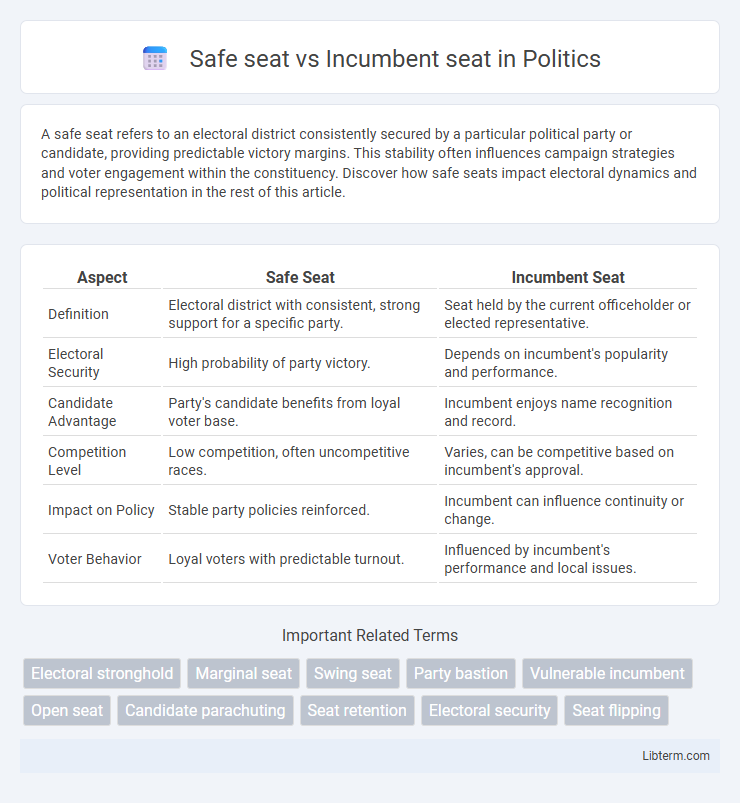A safe seat refers to an electoral district consistently secured by a particular political party or candidate, providing predictable victory margins. This stability often influences campaign strategies and voter engagement within the constituency. Discover how safe seats impact electoral dynamics and political representation in the rest of this article.
Table of Comparison
| Aspect | Safe Seat | Incumbent Seat |
|---|---|---|
| Definition | Electoral district with consistent, strong support for a specific party. | Seat held by the current officeholder or elected representative. |
| Electoral Security | High probability of party victory. | Depends on incumbent's popularity and performance. |
| Candidate Advantage | Party's candidate benefits from loyal voter base. | Incumbent enjoys name recognition and record. |
| Competition Level | Low competition, often uncompetitive races. | Varies, can be competitive based on incumbent's approval. |
| Impact on Policy | Stable party policies reinforced. | Incumbent can influence continuity or change. |
| Voter Behavior | Loyal voters with predictable turnout. | Influenced by incumbent's performance and local issues. |
Understanding Safe Seats and Incumbent Seats
Safe seats refer to electoral districts where a particular political party or candidate has a secure majority, making election outcomes highly predictable. Incumbent seats are held by current officeholders who often benefit from name recognition, established voter base, and access to campaign resources, increasing their chances of re-election. Understanding the dynamics of safe seats and incumbent advantages is crucial for analyzing electoral strategies and predicting political stability.
Defining Key Political Terminologies
A safe seat refers to an electoral district consistently won by a particular political party or candidate with a significant majority, indicating minimal competition or risk of loss. An incumbent seat denotes the electoral district currently held by an elected officeholder seeking re-election, often benefiting from name recognition and established voter support. Understanding these terms is essential for analyzing electoral dynamics, party strategies, and voter behavior in political science.
Historical Context of Safe and Incumbent Seats
Safe seats have historically emerged in electoral systems with strong party loyalty, often resulting from demographic stability and partisan alignment in specific districts. Incumbent seats reflect the advantage held by current officeholders, whose established name recognition and constituent services have traditionally contributed to higher re-election rates since the early 20th century. The interplay between safe and incumbent seats has shaped legislative stability, with incumbency reinforcing safe districts and diminishing electoral competitiveness over time.
Factors Contributing to a Safe Seat
A safe seat in electoral politics is a constituency consistently won by a particular party or incumbent, often due to factors such as demographic alignment with party ideology, strong local party organization, and historical voting patterns. Incumbency advantage further solidifies safe seats through name recognition, access to campaign finance, and constituent services that boost voter loyalty. Geographic homogeneity and socio-economic characteristics of the electorate also play a crucial role in maintaining a safe seat over multiple election cycles.
Advantages Held by Incumbent Candidates
Incumbent candidates benefit from significant advantages such as name recognition, established voter base, and superior fundraising capabilities, which contribute to their electoral success. Safe seats, characterized by strong party loyalty and demographic alignment, further reinforce the incumbent's position by minimizing competitive threats. These factors combined typically result in higher reelection rates for incumbents compared to challengers in more volatile or swing districts.
Electoral Trends: Safe Seat vs Incumbent Seat
Safe seats exhibit consistent voting patterns favoring a particular party, resulting in minimal competition and predictable election outcomes. Incumbent seats, while often benefiting from name recognition and established support networks, can face fluctuations due to shifting voter sentiment and opposition strategies. Electoral trends reveal that safe seats typically experience lower campaign intensity, whereas incumbent seats demand more active engagement to counter emerging challenges.
Party Strategies for Retaining Safe and Incumbent Seats
Political parties allocate significant resources to retain safe seats, where voter loyalty is high and historical data indicates strong partisan support, ensuring minimal risk through targeted campaigning and maintaining consistent constituent services. In incumbent seats, parties emphasize reinforcing the incumbent's visibility and achievements to leverage existing name recognition and voter trust, often deploying personalized outreach and strategic messaging tailored to local issues. Both strategies aim to maximize electoral security by optimizing voter turnout and minimizing opposition gains in districts with established partisan leanings.
Impact on Voter Turnout and Engagement
Safe seats, characterized by strong incumbent party dominance, often lead to lower voter turnout and reduced political engagement due to perceived election predictability. Incumbent seats, while generally favoring sitting candidates, can still witness competitive races that stimulate voter interest and higher participation rates. The presence of genuine electoral competition in incumbent-held districts significantly influences voter motivation and democratic vitality.
Controversies and Criticisms Surrounding Safe and Incumbent Seats
Safe seats often face criticism for undermining democratic competition, as the dominant party or incumbent candidate enjoys disproportionate electoral security, reducing voter choice and accountability. Critics argue that incumbents can leverage resources, name recognition, and redistricting advantages to entrench their positions, fostering complacency and decreasing responsiveness to constituents. Controversies also arise from accusations of gerrymandering and strategic candidate positioning, which manipulate electoral boundaries to create or maintain safe and incumbent seats, distorting fair representation.
Future Outlook: Shifting Dynamics in Electoral Politics
Safe seats, traditionally dominated by incumbents due to strong party loyalty and voter demographics, face increasing challenges from shifting voter behavior and demographic changes. Emerging political movements and increased electoral volatility suggest a gradual erosion of these strongholds, prompting incumbents to adapt strategies for sustained relevance. Future electoral dynamics will likely prioritize responsiveness to local issues and digital engagement to maintain or contest these historically secure positions.
Safe seat Infographic

 libterm.com
libterm.com